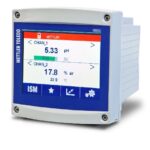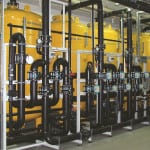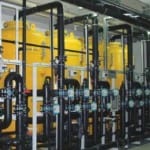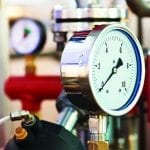
 The costs in regenerating deionization resins are considerable. But accurately predicting resin exhaustion is difficult if feedwater varies in composition. A unique deionization capacity monitoring algorithm monitors the exchange capacity of DI systems and accurately predicts resin exhaustion before breakthrough, regardless of water quality.
The costs in regenerating deionization resins are considerable. But accurately predicting resin exhaustion is difficult if feedwater varies in composition. A unique deionization capacity monitoring algorithm monitors the exchange capacity of DI systems and accurately predicts resin exhaustion before breakthrough, regardless of water quality.
Costly resin regeneration
Deionization resin has a long and respected history in pure water treatment. And despite many advances and new processes for water treatment, ion exchange resins remain by far the most common process for producing the purest waters.
In operation, deionization resins eventually reach exhaustion and need to be regenerated. The costs of regeneration for acid, caustic, etc. are substantial. Anything that can be done to extend run cycles, regenerate more efficiently, or accurately determine the need for resin replacement can bring significant operating savings.
Detecting resin exhaustion
When exhaustion is reached, the resin begins to leach the most weakly held ions. Cation bed breakthrough is usually detected by sodium measurement or occasionally by conductivity ratio. Direct conductivity cannot be used because effluent of a cation exchanger is usually higher in conductivity than the feed, due to its highly conductive acid condition. Instead, the ratio of the conductivity of the effluent to the conductivity of the water is measured.
Anion bed breakthrough is often detected by direct silica and / or conductivity measurement. An increase in either measurement usually indicates exhaustion. Mixed bed breakthrough is almost always monitored by direct conductivity measurement. An accurate and precisely temperature compensated conductivity measurement provides a reliable, low cost, continuous means of detecting exhaustion.
All of these methods are very sensitive and reliable. However, they have a common disadvantage: with the exception of conductivity ratio, they detect exhaustion only after breakthrough has occurred. There is no advance warning. The process downstream begins to receive contamination at the same time the measurement detects it.
Knowing when to regenerate
Common methods for predicting exhaustion are based on elapsed time or totalized flow. If average flow is nearly constant over the run cycle, then a consistent run time before regeneration should be adequate, providing the water composition is also constant. If the flow varies through the exchanger, then a total flow measurement can accurately account for this, but again only if the feedwater composition is constant. If the water composition changes for any reason, then a total flow measurement will not be a good predictor of the optimum time to regenerate.
In today’s environment of scarcer water supplies, power plants are resorting to using multiple sources, recycling and reclaiming, and using variable pretreatment processes ahead of deionization. As a result, variable composition in DI feedwater is becoming the rule rather than the exception. There is a significant need when predicting exhaustion to account for the varying ionic load on a DI bed, due to both flowrate and composition. This need has been recognized and even implemented using a cumbersome combination of instruments. But a neater solution is now available that provides a confident prediction of when regeneration will be required.
Unique tool for predicting resin exhaustion
With the DI-Cap™ deionization capacity monitoring tool on the M800 Transmitter, METTLER TOLEDO Thornton is able to predict resin exhaustion in a standard multi-parameter transmitter monitoring just conductivity and flow.
Feed conductivity is measured and converted to total dissolved solids (TDS) using an adjustable conversion factor and algorithm. This non-linear algorithm corrects for the conductivity of the water itself and for the decreasing activity coefficient of ions at higher concentrations. Flowrate is also measured and multiplied by the TDS value. The product of these is integrated over time to produce a measure of ionic load entering the DI column. The readout on the transmitter can be in grains or ppm-gallons as calcium carbonate, or as equivalents.
This system accounts for both variable flow and variable water composition to give the best available estimate of ion loading. Display, output signals, set points and relays can be assignedto this computed parameter to enable continuous monitoring and control. The total grains measurement can be reset manually or by a remote contact closure at the beginning of a new run.
Greater efficiency of DI systems
Deionization capacity monitoring with DI-Cap provides a significant contribution to the efficient operation and troubleshooting of large DI systems. Deionizing raw water, reverse osmosis permeate, and condensate systems can benefit from this powerful water treatment monitoring tool.
Get a copy of our Conductivity Theory Guide
Visit METTLER TOLEDO Process and Analytics website: https://www.mt.com/pro
Find METTLER TOLEDO on Facebook: https://www.facebook.com/mettlertoledo
Learn about a proactive approach for predicting when resin exhaustion will occur that offers significant benefits over the traditional elapsed time and totalized flow methods. READ MORE
function db_download_file(){
document.write(”);
return true;}
document.write(”);










